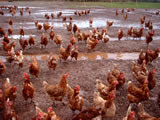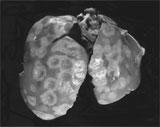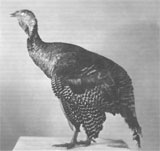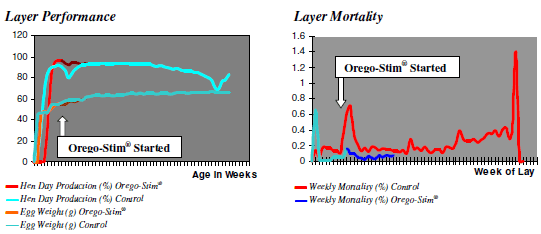



Orego-Stim and Blackhead Disease
Clinical symptoms of blackhead disease (also known as histomoniasis) are described in Technical Bulletin No. 12 from Meriden Animal Health, together with two case histories where the disease was controlled with Orego-Stim.Introduction
 |
 |
 |
Histomoniasis is a worldwide disease of gallinaceous birds caused by a protozoan parasite called Histomonas meleagridis. It was first discovered in 1893 in Rhode Island, reported across the continent and was soon found in many other countries
The disease is better known as blackhead disease amongst poultry farmers, as infections sometimes cause a dark or blackish appearance of the skin of the head in some birds due to an excessive concentration of reduced haemoglobin in the blood or cyanosis. It has always been thought to most seriously affect turkeys, with high mortality nearing 100 per cent of a whole flock, but recent reports have shown that it may also affect chickens and other game birds, causing high morbidity, moderate mortality and extensive culling.
Life Cycle of Blackhead Disease
Like most other parasites, it has a complex life cycle that involves an intermediate host, the common caecal worm, Heterakis gallinae (Gmelin, 1790, Freeborn, 1923) which is synonymous with Heterakis gallinarum (Schrank, 1788). H. meleagridis is most often transmitted to poultry through the eggs of this second parasite, which is commonly found in both chickens and turkeys.
The eggs of the caecal worm may remain infective in the soil for a period of three years or longer and are able to transmit the protozoa responsible for the disease throughout this period.
 |
H. meleagridis may also be transmitted by earthworms that eat the caecal worm eggs. The caecal worm larvae released from the egg and the parasite within that larva may remain in the earthworm for a year or more. When chickens or turkeys eat the infected earthworms, the caecal worm larvae containing H. meleagridis parasites are released, which may resulting in infection.
Poultry may also acquire the organism directly from the droppings of infected birds. However, H. meleagridis found free in faeces and not protected by a nematode egg or the earthworm will die quickly, especially during warm and dry weather.
Clinical Signs
There is usually an incubation period of 15 to 20 days before appearance of the first clinical signs, which are a decrease in feed intake and weight loss. Sick birds appear weak and depressed, often standing by themselves with their heads held close to the body, drooping wings and tails, ruffled feathers and a sleepy appearance. Sulphur-coloured yellow droppings may also be observed. If the affected birds are not treated, or if treatment is delayed, mortality can be very high.
Birds dying of histomoniasis have characteristic enlarged livers with numerous large, circular, crater-like areas of necrosis and thickened caecal walls that are often ulcerated and haemorrhagic. The lumen of the caeca may be obstructed by aggregations of yellowish dry, cheesy material known as caecal cores. Recovered birds may show swollen, hard and scarred livers at the time of slaughter.
A Threat Without A Cure
Although chickens are relatively resistant to the condition, significant cases have been seen in breeding chickens and free-range layer hens, where H. meleagridis may cause an increase in mortality and decreased egg production. In chickens, mortality may be 10 to 20 per cent with high morbidity, although many outbreaks pass unnoticed.
The drug, dimetridazole, which is a nitroimidazole derivative, was once used in the drinking water or feed to control outbreaks of histomoniasis. However, since the ban of nitroimidazole products in the United States and the European Union, an upsurge of outbreaks in turkeys and chickens has been reported. Immunisation is not an option for prevention, as birds do not reliably become resistant to re-infection after suffering a primary exposure.
Recent research demonstrated that histomoniasis could spread rapidly through a poultry flock by direct contact, probably involving the phenomenon of cloacal drinking, where the histomonads are introduced via the cloaca and transported to the caeca by retrograde peristalsis. However, direct transmission was not demonstrated for chickens, stressing the dependence on H. gallinarum as the source of infection.
The lack of suitable treatment drugs or vaccines emphasizes the importance of blackhead disease prevention by a safer, natural means, with the incorporation of strict management and worm control.
How Orego-Stim® Controls and Prevents Blackhead Disease
Orego-Stim is a natural, phytogenic feed additive. Orego-Stim is not only well-known for its antibacterial properties, but also possesses anti-protozoal activities. The mechanism responsible for this anti-protozoal action is the rapid replacement of epithelial cells lining the intestinal wall caused by its active phenolic ingredients.
In the normal intestinal mucosa, the epithelial lining is regularly shed, and replacement occurs by cell division from within the crypts. Phenols act on the gut lining by increasing the rate of enterocyte turnover by about two times the normal rate.
The natural phenols found in Orego-Stim disrupt the life cycle of H. meleagridis by speeding up the rate of shedding of the gut lining. By this mode of action, histomonads are shed before they have the opportunity to penetrate the submucosa and muscularis mucosa, replicate within the caecal tissues and migrate to the liver via the vascular system or through the peritoneal cavity. Orego-Stim therefore prevents or controls histomoniasis by eliminating the parasite before it causes severe damage to the caeca or to the liver.
Case Study I: The Use of Orego-Stim to Control Blackhead Disease
In the past, a large commercial layer integrator in the United Kingdom experienced an increase in mortality for the first time on one of their free-range commercial layer farms that baffled the nutritionist and even the veterinarians that were called in to diagnose the problem. It was later identified by an experienced free-range poultry production expert as blackhead disease. At the time, dimetridazole was used to treat the affected birds and production eventually returned to normal, despite losing quite a number of birds to the disease.
According to the poultry nutritionist in charge of the free-range layers at the time, Orego-Stim was mixed into the feed as a prophylactic measure in the following flock as dimetridazole was banned shortly after the initial outbreak. Orego-Stim successfully prevented future outbreaks of the disease in the free-range layers.
The farm manager also felt encouraged to see an increase in feed intake in the pullets fed with Orego-Stim, especially during the early laying period when pullets are moved to their laying quarters, as they usually do not have a high intake capacity during that period.
Case Study II: The Eifrisch Experience With Blackhead Disease and Orego-Stim
Eifrisch Vermarktung GmbH & Co. Legehennenhaltung is the largest commercial egg producer in Germany, with a total of 1.3 million hens and producing about a million eggs a day.
In the past, Eifrisch constantly battled against severe outbreaks of blackhead disease in their free-range layer flocks, which set a trend of spiking mortality and severe drops in egg production in layers aged between 25 and 28 weeks. As there was no suitable treatment for histomoniasis (with the exception of boosting the immune system of the birds with vitamins), Eifrisch had little choice but to try Orego-Stim in an affected flock. An inclusion rate of 300g of Orego-Stim Powder per tonne of feed and 150ml of Orego-Stim Liquid in 1,000 litres of water was used, which resulted in effective control of the disease.
The control group data was from a similarly affected flock in year 2004, whilst Orego-Stim was started in 2005 and still currently ongoing at a preventive rate of 300g per tonne of feed. Orego-Stim was used in the feed of the free-range layers from week 26 to week 56 of age.
Results of using Orego-Stim in the disease-afflicted flock yielded an additional 1.88 eggs per hen per week compared to the control group, which worked out to be an extra €6,759 of profit, or a 25 times return on investment. At the same time, Orego-Stim prevented the spike in mortality and prevented the deaths of an extra 341 laying hens compared to the control group.

Summary
Histomoniasis can be considered an example of an ancient disease re-emerging in current times, especially in alternative housing systems that are promoted due to modern animal welfare considerations, but which at the same time allow the rapid spread of pathogens in birds for which only few curative drugs are registered. Therefore, new preventive additives that are safe, natural and effective such as Orego-Stim should be gradually introduced to prevent and control the occurrence of the disease, to reduce potential losses and to aid in attaining profitable production.
Further Reading
| - | Find out more information on blackhead by clicking here. |








